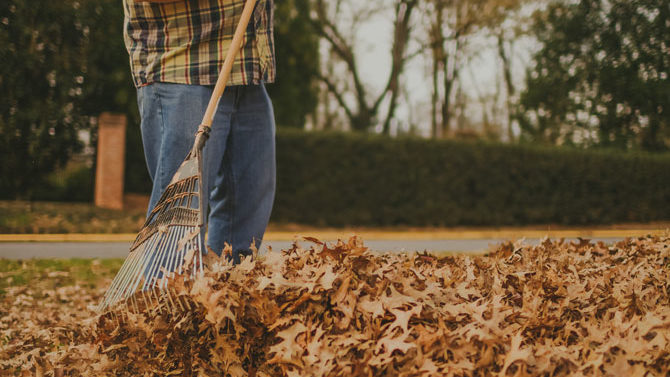“The struggle itself to the heights is enough to fill a man’s heart. One must imagine Sisyphus happy.”
—Albert Camus
Winter is coming. Leaves are on the ground everywhere, especially if you live in the colorful urban forests of Athens-Clarke County. The annual chore of fall cleanup is at its peak with raking, blowing, bagging—repeat, repeat, repeat, like Sisyphus rolling his rock uphill—until the trees are bare and the yard is tidy. What to do with all the leaves? Should we bag them and allow the elusive leaf-and-limb fairies make them disappear? Should we leave the leaves, as the ecologists and environmentalists suggest, or sweep the leaves to the backyard—out of sight, out of mind? There are so many options and oh, so many leaves.
Let us take a look at the options for leaf removal and management here in Athens.
Option 1: Bag the leaves.
The Athens-Clarke County leaf-and-limb services will pick up your bagged leaves every six weeks. The collected leaves will be mulched and composted and sold to the public for a $12 per cubic yard screened compost and a $6 per cubic yard unscreened compost. Rake it, bag it, send it off, and buy it back to spread on your landscape beds to effectively add the nutrients back to your landscape.
In addition to allowing the city to take on your leaf burden, there is the option of finding a farmer for your bagged leaves. As a work/trade laborer for a fantastic organic farm on the outskirts of Athens, we frequently take excursions into the Athens-Clarke County areas that were due for a leaf-and-limb pickup and grab the best of the best high-quality deciduous tree leaves. We use this leaf debris as a mulch cover between rows of crops and around individual plants.
The savvy farmer will readily take your high-quality leaves for mulch cover; these farmers understand that the trees have worked all summer pulling nutrients and minerals from the soil, and not many farmers I know would ever pass up free nutrient-rich mulch. So, if you happen to be one of the citizens who bag their leaves for removal, I suggest you let a local farmer know that you have good-quality bagged leaves, and I would imagine those bags will disappear sooner than later.
Option 2: Leave the Leaves.
A growing contingent of environmentalists and ecologists are telling us to leave the leaves. It’s great for the tree, the wildlife and the soil to have that mulch cover; unfortunately, it is not great for your lawn. Leaves tend to pack flat and smother groundcover plants; this is fantastic for landscaped beds, because it decreases weeds and competition for your ornamental plants. One quick and easy solution is to mow the leaves with a mulching lawnmower. This action does two great things for the lawn: It shreds the leaves, allowing the turf grass to come through, and it adds nutrients and minerals to the lawn. If your yard is like mine and is dominated by a large southern red oak that will not allow turf grass to grow under it, by all means, leave the leaves! But if you have a nice lawn that you love, you should liberate the grass plants by raking and removing or mulch-mowing the leaves.
If removal from the lawn is your choice, I encourage you to move the leaves into garden beds, where they will provide the same function for your landscape. A common practice that I use for my clients is to create mulched landscaped zones in the design. By using your own homegrown leaf mulch, you will discourage the growth of weeds and increase the fertility of your soil, all while saving a significant amount of money and time per year!
Option 3: Compost the leaves.
If you have the space, I recommend composting the leaves yourself into high-quality compost for your landscape gardens. Leaves are high in minerals and will be a great benefit to any and all compost piles. Leaves will break down over time or compost if simply piled up in the corner of the backyard and left for a significant amount of time.
If you would like to speed up the process, the pile of leaves will need to be encouraged to decompose at a faster rate by adding nitrogen, shredding to increase surface area and regular turning.
Pages and pages can be written on the making of compost, but simply put: A high-quality compost can be made by mixing high-nitrogen material, or “greens” (veggie scraps, fresh grass clippings, manure, etc.) and low-nitrogen organic material or “browns” (leaves, straw, cardboard, paper). Compost can be made quickly and efficiently if the mixture of browns and greens is turned and aerated—a great physical exercise for the backyard composter! This rich black compost can be tilled or mulched into the garden, and will greatly benefit your garden and landscape plants.
Finally, to answer the question, “What do I do with all my leaves?” Well, the choice is yours! Bag them and let the city turn them into compost, or donate them to a budget-conscious farmer; spread them on your garden beds and let them decompose over time; or turn them into that black gold yourself.
The one thing to take away from this article is that leaves are not garbage, and if recycled into the landscape will add health and life to your soil. So remember, when you feel like Sisyphus readying to push the boulder up the hill, it should bring a smile to your face to rake those leaves for the benefit of your soil and our environment.
Like what you just read? Support Flagpole by making a donation today. Every dollar you give helps fund our ongoing mission to provide Athens with quality, independent journalism.






